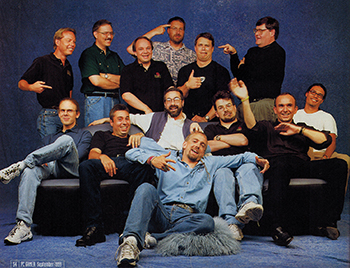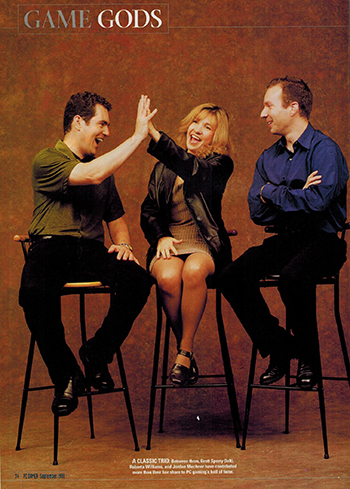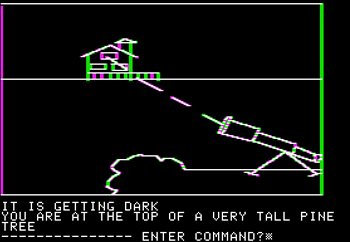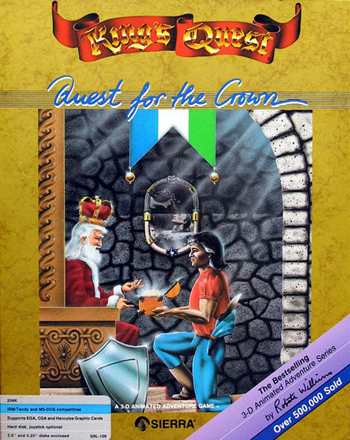A Pedestal, A Table, A Love Letter: Archaeologies of Gender in Videogame History
by Laine NooneyAbstract
The history of videogames has largely been imagined as a patrilineal timeline. Women, when they emerge as participants in the game industry, are typically figured as outliers, exceptions, or early exemplars of “diversity” in the game industry. Yet the common practice of “adding women on” to game history in a gesture of inclusiveness fails to critically inquire into the ways gender is an infrastructure that profoundly affects who has access to what kinds of historical possibilities at a specific moment in time and space. This contribution aims to shift the relevant question from “Where are women in game history?” to “Why are they there in the way that they are?” To do so, the essay strategically deploys Sierra On-Line co-founder and lead designer Roberta Williams as an exceptional case study on the problem of gender in videogame history. Drawing from both media archaeology and feminist cultural studies, this contribution first outlines the function Roberta Williams serves as a gendered subject of game history. The remainder of the essay is organized as three short, non-chronological vignettes about specific objects and practices in the biography of Roberta Williams. Attention to the contextual specificity of Roberta Williams and her historical moment produces an alternative genealogy for gaming centered around relations of intimacy and labor in domestic space. Rather than producing a chronology, the method of this essay illustrates a historical critique by sketching a contour that unsettles the presumptive logic of what we must account for when we write about the objects and subjects of game history.
Keywords: videogame history, media archaeology, Sierra On-Line, Roberta Williams, feminism, gender, women and games, historical method, adventure games, computer games
It should be no revelation whatsoever to state that the history of videogames is a patrilineal chronicle, a forward-marching timeline punctuated by sacred litanies of “founding fathers,” “hacker heroes,” and “game gods.” And in the most naïve historical sense, this may, perhaps, be an accurate representation -- given that the overwhelming majority of game designers, game software producers, and game hardware innovators have been biologically male. Yet this historical impression is not necessarily transparent to itself. In other words, our sense that videogame history is “all about the boys” is the consequence of a certain mode of historical writing, preservation, memory, and temporally specific affective attachments, all of which produce the way we tell the history of videogames.
The origins of videogames have long captured the public imagination -- the earliest published texts on videogame history date back to the early 1980s, and the Internet overflows with game history web journalism, wiki-style crowd source projects, blogs (active and defunct) by lay historians, and a wide range of independent and institutional preservation initiatives [1]. Yet videogame history as a critical writing practice -- circulated by publishers and authorized through citations, indexes, and archival research -- is barely twenty years old, while consistent academic engagement on the subject is roughly half that. In this regard, the first comprehensive videogame history texts emerged in the mid-1990s through early 2000s. Presenting videogame history in broad, chronological strokes, books like Phoenix (1994) and The Ultimate History of Video Games (2001), and coffee table style visual histories such as Supercade (2003) and High Score! (2002) focus on histories of commercial arcades and console games, and the short “pre-history” of playful computational experiments that produced interactions like Tennis for Two or Spacewar! [2]. These texts emphasize the luminous aesthetics and counterculture scenes that dominated the arcades, the three-decades-long competitive sagas of the Console Wars, and the itemization of particularly epic moments in the “evolution” of gameplay. More recent generalist videogame history texts offer chapters that sample important moments, genres or games -- managing to cover most significant “landmarks” while still taking on games as a whole. Only vaguely chronological, books like Replay (2010), All Your Base Are Belong to Us (2011), and Vintage Games (2009) (which is organized alphabetically by game) dart across the historical field, arranged more for thematic holism and narrative pleasure than temporal progression -- although the overall story of technological advancement holds together over each book.
It is these texts, among others, that Erkki Huhtamo (2005) critiques as embodying the “chronicle era” of videogame history, reflected in publications “mainly concerned with amassing and organizing data” (4). According to Huhtamo, the collection and assemblage of facts about videogame objects preoccupies most historical writing, especially by those authors for whom videogames were “a powerful formative experience […] observing games with the eyes of a fan and insider” (4). In Huhtamo's estimation, this results in a history “unable to [be related to] wider cultural framework(s), including contemporary media culture” (4). Under such discursive conditions, videogame history is largely a chronology of its self-declared objects -- the games (software) and the platforms (hardware) that proceed, with each generation, toward ever more mobile, technologically immersive, or narratively complex user experiences. Huhtamo's own project proposes an “archaeology of gaming” consistent with contemporary scholarly approaches in media studies and media history, typically captured under the umbrella of “media archaeology”: the materialist and archaeological turns which privilege non-progressive history, analysis of failed and dead media, and strong attention to technological materiality and medium specificity (rather than a representational or screen-based focus).
What was rippling on the surface of videogame historiography in Huhtamo's 2005 essay boils over as we cascade into 2014. Videogame history is arriving, it seems -- even if we're not sure where. Indeed, this very themed issue of Game Studies cannot help but annotate, and render watershed, the critical interventionist turn within videogame history -- proof that a sympathetic, transdisciplinary militia has arisen to this nearly decade-old call for “wider cultural framework(s).” As Raiford Guins (2014) maintains in his forthcoming monograph Game After: A Cultural Study of Video Game Afterlife, “rigorous scholarship contributing to something that we could confidently call 'historical analysis,' 'game historiography,' or, better yet, 'critical historical studies of video games' is long overdue” (21). Guins offers a call to arms more comparative than evolutionary, skimmed from the top of the finest work in media and technology studies: “Where are game studies' Analog Days; Of Bicycles, Bakelites and Bulbs; Between Human and Machine; More Work for Mother; Make Room for Television; Window Shopping; The Atlas of Emotions; and Aramis, or the Love of Technology?” (21).
In marshaling my own response to such a plea, I am occupied with the historical mechanisms through which gendered bodies become legible to videogame history -- yet media archaeological techniques prove inadequate to account for the category of gender in videogame history. For, what does it mean to “make wider”? If “making wider” is simply an act of adding to a body of already visible thought in order to locate the “roots of electronic gaming” as Huhtamo puts it, then videogame history already does this quite frequently in relation to histories of women. If all we try to do is “widen” the scope of analysis, questions about the relevance of marginalized identities and historically specific subject positions can only be dealt with through an “additive” move, as in: “Oh, let's add women on. Let's put them back in.” Women thus emerge as participants in game history as outliers, canonized in a short array of individual names: Dona Bailey; Carol Shaw; Roberta Williams; Brenda Laurel; Jane Jenson. The historical analysis “widens” to see them, yet cannot account for their historical marginality.
So while my curiosity in locating histories of women and gaming requires a media archaeology of sorts -- only a refusal of teleology can properly hack the timeline -- this must be done with a critical care toward what media archaeology so often ignores: human specificity, the way enactments of power fall upon certain types of bodies more than others. While many of the most provocative and innovative materialist media theories attempt to productively short circuit the subject-object division by displaying how media are active agents in the world, these efforts often wind up simply rearranging actor-network deck chairs, envisioning histories and theories without corporeal or discursive bodies, histories or theories lost in their own love for the mechanism's indifference to the body (which is to say, what makes the virus interesting to media archaeology is that it chews up your hard drive regardless of your subject position).
What follows will be more like a “speleology” than an “archaeology.” I don't want to get out my shovel and “penetrate beyond” historical “surfaces” as Huhtamo (2012) has described the archaeological process in one of his essays (32); I'll settle for something that “gropes toward its limits” as Foucault (1972[1969]) articulates it in The Archaeology of Knowledge (17). Media “archaeology” implies an excavation that brings objects into the light of knowledge, constructing a larger skeleton from the wreckage of bones scattered across the historical field. Spelunking, in contrast, is a phenomenologically imprecise encounter -- I can only see so much at any one time. The shape I hollow out here relies on non-continuity and the inability to apprehend the historical field in its wholeness [3].
Insofar as videogame history struggles to represent itself as much more than a chronology of consoles, games, and programmers, the field fails to critically inquire into the ways gender is an infrastructure that profoundly affects who has access to what kinds of historical possibilities at a specific moment in time and space [4]. Gender dynamics in relationship to technological practices must address how spatial politics, technological and educational access, and social formations set conditions for who might find themselves available to games as a medium to begin with [5]. Because game history is largely concerned with its chronology of objects, and because even Huhtamo's archaeological widening is primarily concerned with adding objects to find “roots” yet to be “excavated,” these methods do not have a broad or embedded sense of what else “might count” as part of such history. The question of rigorously exploring gender as a historical category within game studies deserves better than a merely additive or contextual move of “digging up” a history of women and games [6]. Thus, I depart significantly from other academic game historians, and admittedly operate contra to what one might imagine a feminist videogame history to look like. History is not in what we talk about, but in how we organize its meaning.

Figure 1. Photograph. Courtesy The Sierra Star, August 3, 1983.
I will sketch the contour of these abstract historical and methodological concerns in counterform to a case study on the computer game designer Roberta Williams. In 1980, at the age of 27, Roberta and her husband Ken became the co-founders of the microcomputer software producer Sierra On-Line [7] (See Figure 1). Roberta Williams designed 18 original adventure games over the course of her nearly two decade design career, and is undoubtedly the most frequently cited female designer in videogame history. Yet Williams was quite unlike her male counterparts in the era. Williams did not program. She had no institutional affiliations or interest in technical expertise, and when she left game design in 1998, she essentially evaporated from the scene. She has refused interviews for much of the past decade. She is, quite perfectly, a figure who makes little sense in the history of videogames -- impossible to ignore, yet quick to be forgotten. Thus, the question I want to ask here is not “where is Roberta Williams in game history?” but “why is Roberta Williams there in the ways that she is?” What can Roberta Williams tell us about game history? How is it that she became an object of game history? And by attending to these questions, how might we craft a history which, quite simply, affords more -- not in pursuit of historical “truth” but in the project of sensitizing us to more complex historical textures? If we could better account for the ways power plays with a soft hand, might we “do history better” in addressing the often ghostly realities of privilege, access, affect, and identity that constitute the dirt from which we “excavate” media archaeology's objects? [8]
Follow me, then. I will offer three scenes dropped out of time, three objects: a pedestal, a table, a love letter. They will each provide a path for encountering a question: what counts in game history? How do bodies come to count in game history? How do spaces come to count in game history? How do memories come to count in game history? Against each, I will parcel out a reading of Roberta Williams; their assemblage will carve out conditions of infrastructure and historical embeddedness that I could never twine together on a timeline. If this seems a strange tableau, consider: it may be their discontinuity that shapes a constellation new to the historical night.
Pedestals, or the Body of Game History

Figure 2. Cover of PC Gamer, September 1999. “Game Gods” feature.
In September 1999, PC Gamer offered its readers a front page feature on the 25 “Game Gods” responsible for “some of the most significant, influential, and, gosh damit, fun moments in computer game history” (Lauer, 55) (See Figure 2). An interior full color spread of theses deities complements the cover image, featuring names familiar to any game history aficionado -- Sid Meier, Will Wright, John Carmack, Steve Meretzky, Richard Garriot, among others (See Figures 3a and 3b).


Figure 3. “Game Gods” feature spread from PC Gamer, September 1999, p. 54-55.
A single goddess ripples the otherwise male assemblage: Sierra On-Line co-founder and lead designer, Roberta Williams. Awkwardly perched on a stool with her knees pressed together and her hands spread wide, Williams is easy to spot, caught in a moment of painfully staged excitement! at the prospect of being “together for the first time” with “the world's 25 greatest gamemakers.” Many of her fellow Olympians seem equally uncomfortable, hamming it up for the camera under lackluster art direction. Yet the men who gag the scene point at one another or gesture to themselves, and lounge across each others' bodies on the plush set piece sofas. Warren Spector playfully ruffles what is left of Richard Garriott's hair. There is a quality of comfort and familiarity in many of these gestures, a physiological rendering of that oft-cited “boys' club” that continues throughout the single-page small group portraits that illustrate the feature's bios. Williams' photo shoot with Brett Sperry and Jordan Mechner is possibly the most awkward of those included (See Figure 4); it is one of the only images where no one looks at the camera, and Williams herself not even making eye contact with Brett as she catches his high five. In her stylish leather jacket and camel-colored cocktail dress, Roberta Williams looks uncommonly off point for a game designer who so frequently found herself in front of the camera.

Figure 4. “Game Gods” group portrait spread from PC Gamer, September 1999, p. 64. Brent Sperry, Roberta Williams, and Jordan Mechner.
Williams is subtitled as “Adventure Gaming's Pioneer” in her individual bio, a dubbing all-too-frequent within game history. PC Gamer's article functions as historical by gathering a kind of collective eminence in the individuals it focuses upon, turning each designer's individual point into a cohesive evolution of the videogame medium. In such a chronicle, Roberta Williams is the lone woman of computer gaming history. Her very existence seems to prove the rule, substantiating the sort of claims made in Harold Goldberg's (2011) game history book, All Your Base Are Belong To Us: “[...] sadly, no woman since Roberta has had such a long running impact on games and on game companies. Decades later, Sierra still represents the high point for women in videogames” (158).
Videogame history does not know how to “make sense” of Roberta Williams except to single her out. Hers is a body deeply out of joint in a historical narrative that traditionally locates its origins in the male-dominated camaraderie formed across subculturally “masculine” practices of tabletop gaming, hacking and coding, and technical mastery. Like other women of note who worked in traditionally male-dominated technological fields -- easy analogies can be made to Ada Lovelace or Grace Hopper in the history of computing -- Roberta occupies a pedestal more often than a context, functioning as the gender-balancing notch on a game history timeline that is more than happy to welcome her as an early one-off representative of “women and gaming.”
Yet the marginalizing impulse of this frame is wildly at odds with the historical fact of Sierra's eminence -- given that Sierra On-Line was one of the longest standing, consistently successful home computer game software companies of the 1980s and 1990s, and that Williams herself was the first female game designer producing solely for the microcomputer market [9]. She was the lead designer of the first adventure games with both monochrome and color graphics (Mystery House and Wizard and the Princess, respectively, both 1980), the largest adventure game ever made during the era (Time Zone, 1982, on six double-sided 5.25” disks), the first “adventurization” of a major motion picture (The Dark Crystal, 1983), the first adventure game with environmental “2.5-D” depth in which you could walk around objects (King's Quest, 1984), the first major graphical computer game with a recognizably human female avatar [10] (King's Quest IV, 1988), and the first game to use live action actors (Phantasmagoria, 1995). Furthermore, Williams' games were generally well received, as indicated by her voluminous quantity of awards, bestseller-list standings, genre-ranging productions, and her almost two-decade career in game design. Roberta Williams produces a curious vacuum in game history: so long as she can stand in, everyone else drops out. And the narrowness of this frame routinely fails to acknowledge Sierra's popularity among female players; based on registration card data submitted for King's Quest IV, Sierra estimated that 35-40 percent of that player base was female (Cignarella, 1989, 25). For a franchise that routinely sold roughly half a million or more of a King's Quest game, this suggests that 200,000 of those players in the late 1980s were women. During an era when most game historians believe women didn't play games, Roberta Williams' iconic domestic image was a critical part of the circulation of Sierra's publicity regimes from the mid-80s to the early 1990s. Why does this not make sense?
The cue here should not be that we just need to “better account” or simply “tack Roberta on” to preexisting chronicles of “firsts,” Wikipedic lists of “significant designers,” or, possibly most damaging, a history of “famous women” in gaming. Such additions do little to address the very methodologically systemic reasons that figures such as Roberta Williams, and the lifestyles of play they helped engender, come to be overlooked to begin with. The failure to “make sense” should be the indication that sense-making in the discipline of game history might actually constitute the very bodies we believe we make visible. In fashioning too tight a joint between the object of the game, the practice of play, and the body that enacts gameplay, we get stuck, we fail to move beyond the game, we remain imbued with a bias of chronological rationalization and prefigured presumption of “gamer” identity. In other words, there has always been more girls to game history than Roberta Williams -- we just have not always known where to find them.
Tables, or the Space of Game History
Somewhere that was not quite a beginning, but certainly a start, there was a table. In the late months of 1979, Roberta Williams sat down at this table, a kitchen table, and began to design a computer game. This design contained no code, no instruction sets, no sense of how the game she wrote would function on a computer. Roberta was not a programmer; she was a housewife and mother of two who claimed she “didn't even know how to plug a computer in” (Eklund, 1987, 9). But if not a programmer, she was, by her own admission in later interviews, obsessed; as she put it in 1983, “once I started playing it I realized I'd been waiting my entire life for something like it” (Delson, 1983, 67). She had played Crowther and Woods' Colossal Cave Adventure, first on a teletype machine in the spare bedroom of her home, and later on a microcomputer. When she finished that, she played a few games on cassette -- Softape's Journey, Scott Adams' Adventureland -- but Williams felt she could do just as well at storytelling as the games she had played. So she sat down at her table, not just once but many times over, and she wrote and she sketched [11].
We do not have many details on the initial design processes that brought Mystery House into being. Some of her later works, we know, were designed on the backs of unrolled wrapping paper, or handwritten on legal pads. The table would have been the most obvious surface in the Williams' home large enough to map on, and in most suburban tract houses, especially those of the California ranch style, layouts were such that kitchens gave the optimal domestic observation -- a mother could “work” in a kitchen and still observe the play of her children in another “room” of the home. When Roberta first played Colossal Cave, she admitted: “I just couldn't stop. It was compulsive. I started playing it and kept playing. I had a baby at the time, Chris was eight months old; I totally ignored him. I didn't want to be bothered. I didn't want to stop and make dinner” (Levy, 1984, 296). A baby can be ignored from within a spare bedroom, where she first played Colossal Cave; one can be a better mother from a kitchen table, even if what is “made” there may not be a meal. Thus, perhaps Roberta did not come to the table so much as the table came to her, as an object with agency within a broader condensation of domestic, architectural, and gendered expectations for behaviour and orientation.
The table is a surface we consider, for its material and affective significance, and because: something happened there, in a setting that could have been nothing but utterly, exhaustingly familiar. Roberta Williams' “moment” of designing Mystery House is often historicized in such a way as to illustrate a fracture between the past and present of game history, between the smooth continuity of history, the “implicit density of the already-said” as Foucault (1972[1969], 142) articulates it, and what we retrospectively historicize to prove how, Foucault again, “consciousness awoke from its successive slumbers” (141). In this regard, Roberta Williams' gender and the domestic origin of her game production has often been told as the dramatic rupture categorizing the “epic moment” of Mystery House's design. Yet if we start with “the table” and not with “the game,” Mystery House is precisely the opposite of a “dramatic fracture” with the past. Rather, it is about what was most everyday for Roberta Williams, what was not simply a context but a material instantiation, her self's most intimate horizon of possibility and imagination: home.

Figure 5. Screenshot, Mystery House (1980) On-Line Systems. Public domain.
Mystery House was set in a “large abandoned Victorian house” that was one of the earliest cases, if not the first, of a game taking place in a domestic setting (See Figure 5). The game requires the player to navigate domestic space and utilize mostly everyday objects to reveal secrets that exist beneath and beyond the immediately visible architecture of the home. The home of Mystery House is a space of unexpected distance and dislocation; because of the difficulty of drawing south or bottom screen doorways with the vector-based Versawriter that Williams used, some rooms flip cardinal directions, and the stairwells, secret passageways and trapdoors often defy logical spatial relationship (See Figure 6). The kitchen itself is a crucial locale, the site of three puzzle-solving objects and the secret entrance to an underground pathway that can only be located by smashing a wall with a sledgehammer (See Figure 7). The imagination of Mystery House rests in neither the treasure nor the murders, but in what extends the space of the home; how everyday objects like butter knives and pitchers of water allow one to traverse the flesh of walls. While most games, up to that historical moment, posited their ludic experiences in visions of outer space, fields of physical play, or fantasy caves and dungeons, Mystery House does not share the genealogical investments in space and military research, tabletop gaming, and science fiction enthusiasm that concretized male affinities, affects, and practices around gamemaking. Roberta's “epic act” of designing Mystery House was actually all about what was already familiar to her: a reminder that, as Sara Ahmed (2006) posits in Queer Phenomenology, “space is dependent on bodily inhabitance,” (6) and that the site of historically male game production should not be apprehended as materially neutral “context.” Mystery House signifies where spatial and temporal orientations coalesce, wherein the daily practices of a life accumulate into what becomes “familiar,” “accessible,” “comfortable,” or “at-hand.”

Figure 6. Screenshot, Mystery House (1980) On-Line Systems. Public domain.

Figure 7. Screenshot, Mystery House (1980) On-Line Systems. Public domain.
While what I tease out here operates in collegiality-many scholars in game history are accounting for space, not the least of which would be Huhtamo's (2012) appeal for archaeologies of the domestic culture of gaming [12] -- I would insist that there can be no historicization of domestic space without thorough grounding in the gendered and economic materiality of such space. To do otherwise renders context simply the stage for a theater of objects. Notions of designing “entertainment” for Roberta Williams were implicitly co-relational to a domestic “labor” of cooking, cleaning, and family maintenance. Furthermore, we cannot imagine such space as a “fixed” context into which fall “stable” technologies and “known” bodies. The co-relational character of space as a political and material context of play, of production, of creativity, of technological use, must become recognized as itself constitutive of the very categories that produce subjects within the history of games. And we must shape our categories wisely. When we inquire into “what counts” in game history, that question is beyond the immediately apparent: it is also about how history arrives. How do spaces, bodies, and objects entangle to produce a historical subject -- and why do we presume that this subject is a “gamer”?
Love Letters, or the Memory of Game History
In 1987, Elizabeth Hood wrote a love letter to Sierra On-Line:
“Dear Sierra,
This is a love letter, pure and simple. […] I do not fit the typical profile for adventure gamers. I am a 45 year old woman, who works for LL Bean as a telephone order representative part of the year and travels with her husband the rest of the time. I use the computer in my work for LL Bean. I write (free lance) when I travel, using my home computer primarily for word processing. I love adventure games. Like Roberta Williams, I have always been an ardent reader. I enjoy Shakespeare and Agatha Christie equally well. [...] I am addicted. There seems to be no known cure. I hope no one ever finds one. Please continue to create forever. […] Thanks for everything, especially giving me an opportunity to say how much I love you.
Forever yours,
Elizabeth Hood.”
Elizabeth Hood knew she did not fit in. Her connection to Sierra games, and to Roberta Williams, follows a path that has no origin in the formation of game histories as we have organized them thus far. “Like Roberta Williams, I have always been an ardent reader.” Elizabeth Hood felt she knew what Roberta Williams was about, and saw a reflection of herself there. Roberta Williams was no game god, even in her heyday. Not an idol or a deity. Her design skills were not ones of coding “wizardry” or the rapture of the hack. She described her design habits as beguilingly everyday: they were readerly. As early as 1981, Williams identified herself as a storyteller; by the mid-1980s, Williams described herself as an author, or even a director, rather than a game designer, a positioning that situated adventure games into modes of consumption she was familiar with as a non-programmer [13]. Roberta Williams frequently identified herself in interviews as an avid reader who grew up living in a storyteller's mental fantasy world (Levy, 1984, 295); in a 1993 USA Today article, Williams reported: “I hate the term 'adventure game.' It's so archaic. I really think of them as interactive stories” (Landis, 1993, 3D). Williams privileged efforts of visual and auditory immersion and world building; it was not uncommon for her design requests to demand extensive reworking of game logics on the part of the programmers she worked with (Heitman, interview with author, 4 October 2013). She often spoke of her own role as a designer as “big picture,” a description oddly fitting to her design practice, whether mapping on wrapping paper or filling pages and pages of legal pads with handwritten lists of mythic, fantasy, and folkloric scenarios.

Figure 8. Back of slipcase, King's Quest I: Quest for the Crown. 1987 re-branding. Roberta Williams' image appears in lower right hand corner. Box scan courtesy Museum of Computer Adventure Game History, www.mocagh.org.
Williams' role as “author/director” materialized in the marketing of games themselves. With the 1987 rebranding of the first three King's Quest games -- originally published in 1984, 1985, and 1986, respectively -- and the impending 1988 release of King's Quest IV, Williams' image first appeared on the back of the game boxes [14] (See Figure 8). Beyond this photo, the game is literally “authorized” by the reproduction of Roberta's signature on the front of the slipcase, alongside the sales count (See Figures 9-10).

Figure 9. Front of slipcase, King's Quest I: Quest for the Crown. 1987 re-branding. Roberta Williams' signature appears in lower right hand corner. Box scan courtesy Museum of Computer Adventure Game History, www.mocagh.org.

Figure 10. Front of slipcase, close-up of signature, King's Quest I: Quest for the Crown. 1987 re-branding. Box scan courtesy Museum of Computer Adventure Game History, www.mocagh.org.
Reinforcing this remnant of the artist's hand, the back of the slipcase identifies Roberta as the “bestselling authoress” and “the reigning queen of adventure gaming.” All of Roberta Williams' future games followed this style, including Colonel's Bequest, Mixed-Up Mother Goose, and her opulent gore-fest, Phantasmagoria. King's Quest V and many iterations and re-releases of her other games were identified on the box cover as “by Roberta Williams,” the sort of dubbing that put Williams in the category of “Sid Meier's Civilization.” The game manual for Colonel's Bequest describes it as “A Play by Roberta Williams,” and the game itself uses the progression of eight "Acts" to mark plot advancement. This quality of deliberate authorialism reaches a fever pitch with the 1996 Roberta Williams Anthology, which was very likely the first release of games encompassing the work of a single designer (See Figure 11). The front of the box includes Roberta's face from three different angles -- frontal, three-quarter and profile -- in varying states of pixelation and transparency, surrounded by “classic” objects of adventure gaming, such as an hourglass, wings of flight, a crown, and an antique door handle and key.

Figure 11. The Roberta Williams Anthology. 1996. Box scan courtesy www.sierragamers.com.
Roberta Williams' face on a game box resonates with the complex intersections sutured by Hoods' letter: the sociocultural distinctions that distinguished women from more commercially represented gamer subcultures, the significance of both workplace and domestic access to computers as a prerequisite for women's play, and the tie to older traditions of women's leisure reading. Hood carries an acute awareness of her ill fit within the adventure game subculture, but this conception may have been more perceptual than actual -- there was no practical way for her to know who was playing these games. The world of easily accessible internet forums and communities dedicated to gaming wes still years away for most users, while computer gamer magazines such as Computer Gaming World or Electronic Games were more specialized in hardcore game players, players whose primary activity was gaming, namely young males with disposable incomes and twitchy fingers. Hood did not imagine herself as a gamer, and therefore we do not remember her as one. The question of who is the subject of game history is sticky. In light of Elizabeth Hood's love letter, we might position this question in a more reflexive way: what does it mean to remember yourself as a part of game history?
Inconclusions
In the Fall of 2012, I traveled to Copenhagen to give a talk on Roberta Williams at the annual conference for the Society for the History of Technology, as part of a panel on the cultural origins of personal computing. After my talk, a woman came up to me, a social scientist who had no disciplinary ties to the history of computing, and told me she attended the panel just because she saw the name Sierra On-Line in the title of my paper. She had played Sierra games as a child. She thanked me for my paper and eagerly recollected with me. We traded memories of scenes and puzzles (“No, King's Quest II had the three witches with the eyeball, in King's Quest I Graham had to push the witch from Hansel and Gretel into the oven!”), then went on our ways for the next session. The following day, this woman approached me again, letting me know that she had been reminiscing about King's Quest games all night. And then she said: “I never realized I was a gamer until now.”
This statement hung with me. The day after returning from Copenhagen, I gave my regular Sierra On-Line guest lecture in Raiford Guins' videogame history class [15]. A 30-year old female student raised her hand and told me that she and her mother used to play Sierra games together. But when Sierra stopped making them, she said she and her mom “just went back to reading books.” And then, a few months later, I located an obscure archival group interview (Eklund, 1987) in the holdings of the Smithsonian, a one-off video documenting original members of the early 1980s Apple II scene, including Ken and Roberta Williams (See Figure 12).
EKLUND: What had been your experience, Roberta, with computers before you and Ken bought the Apple in -- was it '79?R. WILLIAMS: It was January 1980.
EKLUND: 1980.
R. WILLIAMS: It was right after Christmas of 1979. My experience with computers was really pretty limited, and even to this day, I'm not a technical person at all. I don't feel comfortable with computers. I don't even know how to plug a computer in, you know. I don't know why I'm in this industry. [Laughter] But my experience -- I did learn how to program a little bit in COBOL.
EKLUND: What made you want to do this game? Were you like Margot [Comstock]?
R. WILLIAMS: A computer fiend?
EKLUND: No, not computers. Just a game player.
R. WILLIAMS: A game player. I don't even consider myself a game player. I must be very unusual, because people look at me and say, “You don't look like a computer nerd, you know, or anything like that.” I don't program, and I'm not technical, and I'm not even a game player. So you know, everybody says, “Well, what are you doing in this industry?” [Laughter]
The laughter feels more nervous than brackets can express. “What are you doing in this industry?” Jon Eklund, her interviewer, does not know what to call her. Eklund and Williams pass words back and forth -- computer fiend, game player, computer nerd -- but the word we would use today does not seem to yet exist: gamer. Gamer has a history. And it has played a role in organizing our history.

Figure 12. Roberta Williams. Screencap. Smithsonian Institution Archives, Record Unit 9533 Minicomputers and Microcomputers Interview, 1987.
Roberta Williams was not a gamer. Neither was Elizabeth Hood. Nor the woman I met in Denmark. Nor the student in my advisor's class. Nor myself. So are gamers what people are, or how they remember themselves to be? Jesper Juul (2010) has brushed across such murky complexities in his book The Casual Revolution, noting that games are becoming a “new normal,” largely because people who had once played games in the 1980s and stopped during the rise of complex hardcore games were playing them again under the new awning of “casual games.” Juul writes:
By now I do understand why some would not feel that pull. I understand the frustration of not knowing which buttons to push, of being unfamiliar with the conventions on the screen, of being reluctant to invest hours, days, and weeks into playing this game, of being indifferent to the fiction of the game, of having a stupid machine tell you that you have failed, of being unable to fit a game into your life (5; italics in the original).
Juul affirms that gameplay has long been more diverse than we can easily account for, yet the writing of game history as remembered also plays a role beyond Juul's scope. Is the weird historical trick here that what we have written thus far are not histories of gaming but a history of gamers -- and that is why so much gets left out? The curious lives of Roberta Williams, of Elizabeth Hood, of the women who make confessions of their ludic pasts to me at conferences, suggest that we may need to flip the sentence: what does it take for a life to fit a game? Within game history, the only people we have made historically visible are those we have organized ourselves to see, those who have made the game a certain type of culture. But there have been others. In the case of my colleague in Denmark, she forgot. In the case of that student, she went back to books. In the case of Roberta Williams, she gave up game design in 1998 and has refused interviews for nearly a decade, always, always riffing to the same refrain: “I don't do Sierra anymore.” In the case of myself, I stand around, trying to feel out a history not of gamers past, but of bodies that mostly remain un-subject to our history.
Endnotes
[1] For a thorough summary of the varied stakeholders and projects circulating as part of videogame historical discourse, see Guins (2014, pp. 18-26).
[2] My interest is in texts that offer a widescale chronology or completionist history of videogames. Thus, I overlook the numerous books written about individual platforms, companies, designers, or genres.
[3] It is tempting, given the feminist theoretical aims of this essay, to interpret my turn from archaeology to speleology as a “return to the womb” so to speak. Psychoanalytic discourse typically interprets the cave (or any “hollow” structure or architecture) as a representation of female sexuality, part of a complex of longing and disavowal for the mother and an unconscious expression of castration anxiety. Luce Irigaray (1985[1974]), in her deconstruction of Plato's Allegory of the Cave, argues that dissociation from the cave is the foundation of Western metaphysics' phallogocentrism. According to Irigaray, Plato elides the significance of the cave as origin by rendering it a “mere dark [hole] in which lucid reason risks drowning” (302). Such a substantial body of philosophical, theoretical, and feminist thought is admittedly present in my thinking, and I am certainly not above provoking a little castration anxiety in the largely male-dominated field of media archaeology. However, I am also deeply invested in this turn as more than metaphor. The material affordances and limitations of caving, the way caving thwarts any attempt at totalized representation, have been powerful tools for imagining how I might produce flexible and politically accountable historical claims -- even when what I'm looking for cannot be “seen.”
[4] While there have been a handful of essays on gender, space, and game history, they remain largely in the realm of the propositional, and were published before the rising tide of videogame history brought more sustained attention to historical practice. See Guins (2004) and Jenkins (1998).
[5] The question of how and under what conditions women encounter games or participate in their production has been posed by scholars such as Mary Flanagan (2009) and Celia Pearce (2009), both of whom have theorized the intersection of play practices, embodiment, and gender. While both authors have produced relevant historical sketches of non-mainstream game phenomena, the authors do not identify as historians and are not deeply engaged with historical methodology as such; the history they provide in their respective monographs is more complementary to a presentist focus on these issues.
[6] For further theorization of the “problem” of gender in historiography generally, see Scott (1986, 1991).
[7] Sierra On-Line was originally called On-Line Systems. The name was changed roughly around September 1982, two years after the Williamses relocated to the Coarsegold/Oakhurst area on the Western edge of Yosemite National Park.
[8] My thinking on the materiality of the “ghostly” is deeply informed by Avery Gordon (2008[1997]) and her book Ghostly Matters: Haunting and the Sociological Imagination. Gordon describes haunting as “mediation” in which “organized forces and systemic structures that appear removed from us make their impact felt in everyday life in a way that confounds our analytic separations and confounds the social separations themselves” (19).
[9] Williams was not the first commercial female game designer -- that precedent goes to Carol Shaw and her game 3-D Tic-Tac-Toe.
[10] Super Mario Bros. 2, which offered Princess Peach as a playable avatar, was released for the NES in 1987. To the author's knowledge, this is the only significant precedent for a graphical game with a playable female avatar -- although in Super Mario Bros. 2, Peach is offered as one of four avatars a player might select. In King's Quest IV, Princess Rosella is the only available avatar.
[11] Precise information on the creation of Mystery House is fairly inconsistent. See Eklund (1987, pp. 10-11); Levy (1984); Tommervik (1981, p. 4); Williams, K. (1997); Williams, R. (1981).
[12] See Huhtamo (2012) for his archaeology of gaming in domestic space -- an archaeology which posits the home as a site of leisure, rather than labor.
[13] For just a few examples of Williams' tendency toward authorial identification, see Delson (1983, p. 66); Eklund (1987, p. 11); Williams, R. (1981).
[14] While this was the first time Roberta's image appeared on the back of a slipcase, she was not the first Sierra designer featured in such a way. The designers of Space Quest, Mark Crowe and Scott Murphy (known as The Two Guys from Andromeda), were featured on the back of the 1986 game Space Quest: The Sarien Encounter, wearing their characteristic red mohawks and pig snout masks.
[15] I was a graduate student at Stony Brook University at the time of these guest lectures.
References
Ahmed, S. (2006). Queer Phenomenology: Orientations, Objects, Others. Durham, NC: Duke UP.
Burnhan, V. (2003). Supercade: A Visual History of the Videogame Age, 1971-1984. Cambridge, MA: MIT Press.
Cignarella, P. (1989, Autumn). Roberta Williams: Girls Just Want to Have Fun. Sierra News Magazine, 2.2, 22, 24-25.
Delson, J. (1983, December). A Young Girl's Fantasy Turns to Fortune. Family Computing, 1.4, 66-9.
DeMaria R. and Wilson, J. L. (2002). High Score!: The Illustrated History of Electronic Games. Berkeley, CA: McGraw-Hill.
Donovan, T. (2010). Replay: The History of Video Games. East Sussex, UK: Yellow Ant.
Eklund, J. B. (interviewer) and Albert, D., Carlston, D. G., Comstock, M., Jewell, J. W., Williams, K., and Williams, R. (interviewees). (1987). [Interview transcript]. Smithsonian Institution Archives, Record Unit 9533 Minicomputers and Microcomputers Interview.
Flanagan, M. (2009). Critical Play: Radical Game Design. Cambridge, MA: MIT Press.
Foucault, M. (1972[1969]). The Archaeology of Knowledge and the Discourse on Language. New York: Pantheon Books.
Goldberg, H. (2011). All Your Base Are Belong to Us: How Fifty Years of Videogames Conquered Pop Culture. New York: Three Rivers Press.
Gordon, A. (2008[1997]). Ghostly Matters: Haunting and the Sociological Imagination. Minneapolis, MN: University of Minnesota Press.
Guins, R. (2004). 'Intruder Alert! Intruder Alert!' Video Games in Space. Journal of Visual Culture 3.2, 195-210.
Guins, R. (2014). Game After: A Cultural Study of Video Game Afterlife. Cambridge, MA: MIT Press.
Heitman, R. (2013, October 4). Phone Interview.
Herman, L. (1999). Phoenix: The Fall and Rise of Videogames. 2nd ed. Union, NJ: Rolenta Press.
Hood, E. (1987). Letter to the Editor. Sierra Newsletter, 1.2, 14.
Huhtamo, E. (2005). Slots of Fun, Slots of Trouble: An Archaeology of Arcade Gaming. In J. Raessens and J. Goldstein (Eds.), Handbook of Computer Games Studies (pp. 3-21). Cambridge, MA: MIT Press.
Huhtamo, E. (2012). What's Victoria Got to Do with It?: Toward an Archaeology of Domestic Video Gaming. In M. J. P. Wolf (Ed.), Before the Crash: Early Video Game History (pp. 30-52). Detroit, MI: Wayne State University Press.
Irigaray, L. (1985[1974]). The Speculum of the Other Woman. Ithaca, NY: Cornell University Press.
Jenkins, H. (1998). 'Complete Freedom of Movement': Video Games as Gendered Play Spaces. In J. Cassell and H. Jenkins (Eds.), From Barbie to Mortal Kombat: Gender and Computer Games (pp. 262-97). Cambridge, MA: MIT Press.
Juul, J. (2010). A Casual Revolution: Reinventing Video Games and Their Players. Cambridge, MA: MIT Press.
Kent, S. L. (2001). The Ultimate History of Video Games. New York: Three Rivers Press.
Landis, D. (1993, May 27). A Genre Built on “Mystery House.” USA Today, p. 3D.
Lauer, A. (1999, September). Game Gods. PC Gamer.
Levy, S. (1984). Hackers: Heroes of the Computer Revolution. New York: Penguin Books.
Loguidice, B. and Barton, M. (2009).Vintage Games: An Insider Look at the History of Grand Theft Auto, Super Mario, and the Most Influential Games of All Time. Burlington, MA: Focal Press.
Pearce, C. and Artemesia. (2009). Communities of Play: Emergent Cultures in Multiplayer Games and Virtual Worlds. Cambridge, MA: MIT Press.
Scott, J. W. (1986). Gender: A Useful Category of Historical Analysis. American Historical Review, 91.5, 1053-75.
Scott, J. W. (1991). The Evidence of Experience. Critical Inquiry, 17.4, 773-97.
Tommervik, A. (1981, February). On-Line Exec: Adventures in Programming. Softalk, 4-6.
Williams, K. (1997). Introduction. The Roberta Williams Anthology Manual.
Williams, R. (1980). Mystery House. On-Line Systems.
Williams, R. (1980). The Wizard and the Princess. On-Line Systems.
Williams. R. (1981). Winning Strategies for Adventures. The On-Line Letter, 1.1, 7.
Williams, R. (1982). Time Zone. On-Line Systems.
Williams, R. (1983). The Dark Crystal. Sierra On-Line.
Williams, R. (1984). King's Quest. Sierra On-Line.
Williams, R. (1988). King's Quest IV: The Perils of Rosella. Sierra On-Line.
Williams, R. (1995). Phantasmagoria. Sierra On-Line.